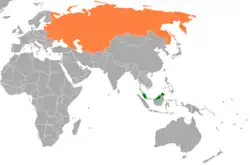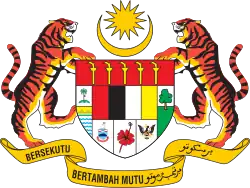Malaysia–Soviet Union relations
Malaysia–Soviet Union relations (Malay: Hubungan Kesatuan Soviet–Malaysia; Jawi: هوبوڠن كساتوان سوۏيايت–مليسيا; Russian: Малайзийско-советские отношения Malayziysko-sovetskiye otnosheniya) refers to the historical relationship between Malaysia and the Soviet Union.
 | |
Malaysia |
Soviet Union |
|---|---|
History
Despite Malaysia's early anti-communist foreign policy due to the Malayan Emergency, the two nations established diplomatic relations on 3 April 1967.[1][2][3][4][5] Following the establishment of relations, Malaysia also expanded and established relations with other Soviet-influenced countries such as Poland, Romania, Hungary, Czechoslovakia, the German Democratic Republic and Yugoslavia.[2] During the time, the Soviets were also keen to develop the relations by promoting Russian culture through the exchange of radio and television programmes, artists and in the educational field.[2] However, throughout the Cold War, relations were often tense due to Malaysia's opposition to the Soviet invasion of Afghanistan, the Soviet role in the Vietnam War and Soviet intervention in the Indian Ocean which Malaysia felt could lead to the fulfillment of the domino theory.[2]
Economic relations
The Soviet Union was one of the largest customers of Malayan rubber during the 1950–1960 period, and displaced the United States as the largest purchaser of natural rubber with 134,000 tons purchased between January and July 1963 compared to the United States with only 96,000 tons.[6] However, all the purchases were made through the London market as to avoid friction with Indonesia, who was also a producer of rubber in the region.[7] In 1967, Malaysia also signed a trade agreement with the Soviet Union which was considered as the country's first agreement with a communist country, and as a prelude to full diplomatic relations.[8]
Further reading
See also
References
- George Ginsburgs; William B. Simons (1988). The Soviet Union and International Cooperation in Legal Matters: Recognition of arbitral agreements and execution of foreign commercial arbitral awards. Martinus Nijhoff Publishers. pp. 73–. ISBN 90-247-3677-3.
- Christoph Marcinkowski; Constance Chevallier-Govers; Ruhanas Harun (2011). Malaysia and the European Union: Perspectives for the Twenty-First Century. LIT Verlag Münster. pp. 40–. ISBN 978-3-643-80085-5.
- Victor Sumsky; Mark Hong; Amy Lugg (30 May 2012). ASEAN-Russia: Foundations and Future Prospects. Institute of Southeast Asian Studies. pp. 185–. ISBN 978-981-4379-57-1.
- Leszek Buszynski (13 September 2013). Soviet Foreign Policy and Southeast Asia (Routledge Revivals). Routledge. pp. 12–. ISBN 978-1-134-48085-2.
- "Russian-Malaysian Relations". Embassy of the Russian Federation in Malaysia. Retrieved 29 December 2017.
- Geoffrey Jukes (1 January 1973). The Soviet Union in Asia. University of California Press. pp. 302–. ISBN 978-0-520-02393-2.
- Geoffrey Jukes (1 January 1973). The Soviet Union in Asia. University of California Press. pp. 254–. ISBN 978-0-520-02393-2.
- Jayaratnam Saravanamuttu (2010). Malaysia's Foreign Policy: The First Fifty Years : Alignment, Neutralism, Islamism. Institute of Southeast Asian. pp. 99–. ISBN 978-981-4279-79-6.

.svg.png.webp)

